 About F&D Subscribe Back Issues Write Us Copyright Information Use the free Adobe Acrobat Reader to view a pdf file of this article
|
Trade Liberalization in the Caribbean Janet Stotsky, Esther Suss, and Stephen Tokarick
During 1994-98, the economic performance of the Caribbean region (Antigua and Barbuda, The Bahamas, Barbados, Belize, Dominica, Grenada, Guyana, Jamaica, St. Kitts and Nevis, St. Lucia, St. Vincent and the Grenadines, Suriname, and Trinidad and Tobago) was broadly satisfactory—though characterized by wide variation among countries—notwithstanding the international financial turmoil that affected many developing economies in Latin America and Asia. Real GDP grew about 21/2 percent a year during 1994-98, ranging from growth of more than 7 percent a year for Suriname to a decline of about 1/2 of 1 percent a year in Jamaica (Table 1). Inflation remained low in general, and the balance of payments remained viable, with the external current account deficits more than covered by inflows of direct investment and concessional assistance. This performance reflected, to a large extent, sound macroeconomic policies and structural reforms, most notably privatization and efforts to enhance competitiveness in the services sector (for example, in telecommunication services). In 1998, the region had a total population of about 61/2 million and a combined GDP of about $24 billion, resulting in an income per capita of about $3,700, compared with about $3,900 for Latin America.
|
|

Traditional economic activities—such as agriculture and extraction of natural resources—continue to underpin the Caribbean economies, although in recent years there has been a shift into tourism and other services. By virtue of their size, these economies are very open, with exports and imports of goods and services both averaging more than 100 percent of GDP. Their high degree of openness, coupled with relatively narrow production and export bases, leaves many of the countries vulnerable to external shocks. External shocks may, however, affect Caribbean countries differently. For example, the recent rise in world oil prices has boosted the export earnings of Trinidad and Tobago, an oil-exporting country, but increased import costs for much of the rest of the region. In recent years, many of these countries have seen their preferential export arrangements diluted or threatened, and some have been faced with the loss of export and other trade privileges for their main products (including bananas, garments, and sugar). In addition, there has been a reduction in concessional aid and external grants received by countries in the Caribbean region. Since the mid-1990s, the Caribbean governments have taken important steps to increase the integration of their economies into the world economy in order to increase productivity. These have largely taken the form of regional trade integration, which is seen as a step toward establishing even closer forms of monetary and economic cooperation. In this regard, the Eastern Caribbean Currency Union and its associated Eastern Caribbean Central Bank—which were created in 1983 and whose members include Anguilla, Antigua and Barbuda, Dominica, Grenada, Montserrat, St. Kitts and Nevis, St. Lucia, and St. Vincent and the Grenadines—have been quite successful in maintaining a stable exchange rate and low inflation. The global integration movement started with the removal (or reduction) of trade and payment restrictions in the 1980s. In this first phase, countries began to dismantle import and export licensing arrangements and reduced foreign exchange controls. Further trade liberalization measures were undertaken in the 1990s. Recently, the Caribbean countries entered into an arrangement with several Latin American countries to form the Association of Caribbean States. The Caribbean countries have also signed various protocols with larger markets, including the United States (the current Caribbean Basin Initiative). In addition, they are aiming to establish a single market and economy under the Caribbean Community (CARICOM) in the next few years. While it is difficult to gauge the impact of trade liberalization so far, preliminary indications are that it has benefited the Caribbean countries by expanding their exports of goods and services, which has boosted their economic growth. The reduction in import tariffs, which has been an integral part of the trade-liberalization strategy, appears to have reduced tax revenue in some countries, highlighting the need for appropriate reforms of tax systems. Recent progress in trade liberalization The creation in the 1970s of a common market applying to trade within the Caribbean and the elimination of most quantitative restrictions were major steps in the integration process. The adoption in 1973 of the Common External Tariff (CET), which applies uniform tariffs to imports from outside the region, was another significant step toward the integration of the region with the rest of the world, as were protocols on trade in services and the free movement of labor and capital within the region. This liberalization led to an increase in the region's total exports, particularly of nontraditional commodities, as well as larger intraregional trade flows. To accelerate the progress in trade liberalization in line with global trends, CARICOM countries agreed to a schedule of phased reductions in the CET starting in 1991. The objective was to reduce the maximum CET in steps from 45 percent to 20 percent by 1998. Tariff rates imposed under the CET depend on the nature of the taxable commodity. Most commodities are grouped as competing (if regional production satisfies at least 75 percent of regional demand) or noncompeting, and then each group is subdivided into inputs (primary, intermediate, and capital) and final goods. The rate structure is 0 or 5 percent on noncompeting inputs, 10 percent on competing primary and capital inputs, 15 percent on competing intermediate inputs, and 20 percent on all final goods. (The CET agreement also allows for a special rate on agricultural products, limited duty exemptions related to economic development, and some additional national discretion in the setting of tariff rates.) About half of the countries in the region—which account for the majority of its trade—have implemented the final reductions of the CET. Some of the others, especially those with the smaller economies, have found it difficult to implement the final reductions, mainly because of their inability to replace lost revenues and concerns about the ability of their domestic producers to thrive in a more competitive environment. When revenue considerations permit, the CARICOM countries should make further cuts in their highest tariff rates to reduce tariff dispersion and effective protection. Effects of trade liberalization How do trade liberalization's benefits compare with its costs? On the one hand, the benefits accrue because of lower input costs for producers owing to the reduced tariffs, a wider variety of goods available to consumers at lower prices, and enhanced export prospects as employment and output increase in the exportable goods and services sectors. On the other hand, tariff cuts could lead to a reduction in output and employment in certain sectors that face greater competition from lower-cost foreign products. The net outcome invariably depends on the structure of the economy and the flexibility of wages and prices to allow the full readjustment of relative prices following trade liberalization. In most countries, the beneficial effects are likely to predominate. For the Caribbean region, preliminary evidence suggests that trade liberalization has brought significant net benefits. After trade barriers among countries in the region were removed in the 1970s, the reductions in the CET were expected to lead mainly to increased imports from countries outside the region and—as trade liberalization led to a more efficient allocation of resources—increased exports. Imports by CARICOM countries—both from other CARICOM countries and from countries outside the region—have increased, as a percentage of GDP, since cuts were made in the CET (Table 2). Although total exports from the region have also grown since liberalization, they have not increased as rapidly as imports. A major constraint on growth of the region's exports has been the decline since 1994 in commodity exports, particularly banana exports from the Organization of Eastern Caribbean States (OECS) countries, because of bad weather and the loss of preferential access to markets. Nontraditional exports, including agricultural produce (but excluding sugar and bananas), increased over the period, with countries moving toward greater specialization by producing goods and services in which they have comparative advantages, such as tourism.

By allowing prices more closely to reflect production costs, trade liberalization has brought about a shift of resources to sectors in which Caribbean countries have comparative advantages. The exportable service sectors have expanded, with tourism and information services growing to about 40 percent of GDP in 1998 from about 25 percent in 1994. Some exportables sectors have contracted, however, because of greater competition from producers outside the region and from trade agreements elsewhere in the Western Hemisphere, such as the North American Free Trade Agreement (NAFTA), which extended trade preferences to Mexico but not to the Caribbean region. An example is the garment industry, which expanded rapidly in the 1980s but started contracting in the 1990s as trade liberalization intensified. Finally, trade liberalization improves the welfare of a country's people. Apart from the wider variety of goods that become available, indications are that these goods are available at lower prices than previously. The import content of the baskets of consumer goods and services used in all of the Caribbean countries is very high—ranging from about 75 percent in St. Kitts and Nevis to 50 percent in Jamaica. After one adjusts for policy changes that could make comparisons misleading—such as fiscal measures involving increases in taxes on imports—the available evidence suggests that the domestic prices of Caribbean countries' imports rose more slowly than before-tariff import prices. Available data indicate that trade liberalization has contributed to greater overall investment in the region. Although investment as a share of GDP varied considerably among countries, total investment for the region rose to 281/2 percent of regional GDP in 1998 from 261/2 percent in 1994. Foreign direct investment increased to 61/2 percent of regional GDP from about 41/2 percent during the same period. The reduction in tariffs helped reduce the costs of capital and intermediate goods that are crucial to expansion of the manufacturing sector in the region's larger economies—Barbados, Jamaica, and Trinidad and Tobago. Revenue effects and further tax reform Because international trade taxes—such as customs duties and service charges—are major sources of revenues for most CARICOM countries, the effects on revenue of reductions in tariffs are important (see Ebrill and others, 1999). Trade liberalization led to a reduction in the overall ratio of import duties to the value of imports, as measured by the collected tariff, to 61/4 percent in 1998 from about 81/4 percent in 1994. Tariff revenue fell to 41/2 percent, from about 41/4 percent, of GDP even though the value of imports rose to 46 percent, from about 40 percent, of GDP during the same period. Trade liberalization and the likely loss of revenue resulting from it make it imperative for Caribbean countries to undertake further tax reforms. These reforms should concentrate on broadening and strengthening domestic taxation, as well as harmonizing taxes across the region to achieve closer economic integration and easier administration. Efforts should be made to harmonize and strengthen domestic sales taxes, as was done in Barbados and Trinidad and Tobago, where value-added taxes replaced the existing, poorly structured consumption and special services taxes. In many Caribbean countries, existing consumption taxes tend to exclude services and distributive margins, and to cover the services sector—the most rapidly growing sector in their economies—either poorly or in a distortive way. As a first step for those countries without a value-added tax, the consumption tax could be reformed so that it more closely approximated a value-added tax—that is, became similar to the general consumption tax (GCT) in Jamaica or other value-added taxes in the region. Adoption of a well-structured value-added tax would help eliminate distorting effects on consumption and production decisions, remove cascading of taxes (multiple taxation of the same good as it is resold up the production chain—for example, moving from importer to wholesaler to retailer), and relieve the tax burden on exports of goods and on the use of capital goods. However, to ease administration, the value-added tax should allow for a threshold below which small taxpayers would not be obligated to register for or pay the tax. Also, excise taxes could supplement broad-based consumption taxes in countries' systems of taxation and should apply equally to domestic production and imports (and should be rebated on exports). They should be confined, however, to a narrow range of products—such as alcohol, tobacco, and petroleum—that would yield substantial tax revenues (see IMF, Fiscal Affairs Department staff, 1995). Conclusion Trade liberalization has provided the Caribbean countries with increased opportunities, but their progress has to be assessed in the context of the trade liberalization that has occurred elsewhere. If their external competitiveness is not to be eroded, the Caribbean countries will need to liberalize trade as quickly as countries in competing regions (especially Central and South America). Because trade liberalization may increase competition from abroad and lead to the loss of some preferential trading arrangements, it must be accompanied by reforms to improve productivity and reduce costs if Caribbean countries' market shares are to expand. Price and wage flexibility is therefore needed to allow resources to be used more efficiently following trade liberalization. Finally, it must be emphasized that the most important component of trade liberalization is the reduction in the overall level of tariffs. If a reduction in the CET is offset by other taxes on trade (stamp duties, import surcharges, and discriminatory domestic consumption taxes) because of concerns about possible revenue losses, then the hoped-for benefits may not be forthcoming. Policymakers should therefore address revenue concerns by reforming countries' tax systems, including, most importantly, replacing existing consumption and special services taxes where necessary with value-added taxes, reducing duty exemptions, improving tax and customs administrations, and harmonizing taxes across the region.
References: Liam Ebrill, Janet Stotsky, and Reint Gropp, 1999, Revenue Implications of Trade Liberalization, IMF Occasional Paper No. 180 (Washington: International Monetary Fund). IMF, Fiscal Affairs Department staff, 1995, "Domestic Consumption and Production Taxes," Chapter 3 in Tax Policy Handbook, ed. by Parthasarathi Shome (Washington: International Monetary Fund), pp. 71-118.
|